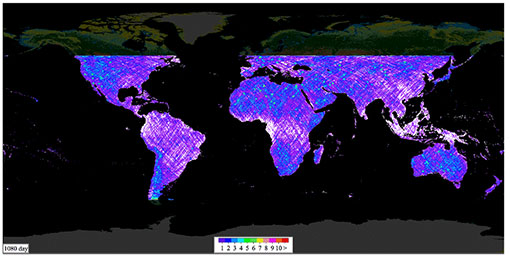Mission Planning
Observation plan is made to best accommodate the data observation requests from various users within the limited observation resources. Cloud cover content and image quality are assessed soon after the processing and a new observation is scheduled if re-observation is determined to be necessary.
Long-term Observation Plan
In the HISUI observation plan, limited observation resources are allocated appropriately by classifying observations into three categories
- Regional Monitoring (RM)
- Observation of the specified local region periodically
- Priority Mapping (PM)
- Observation of wide area on a priority
- Global Mapping (GM)
- Observation of global land and shallow sea area using the remaining observation resources
Long-term observation plan is made after the simulation is performed elaborately according to the above scheme.
Long-term simulation
Observation is simulated over a year using the global cloud cover distribution data obtained from the past satellite observation. General principles of HISUI operation are establishedand necessary resources (observation time, data downlink volume) are calculated based on the results.
Example of the long-term simulation: (right image)
The figure is the result of a long-term simulation of three-year operation period. The black regions show no planned observations, the white regions show only cloud cover data, and the other colors show the number of times cloud-free data was observed.
Based on these results, we estimate that HISUI will obtain cloud-free data for more than 90% of the priority observations and more than 70% of the global observations.
